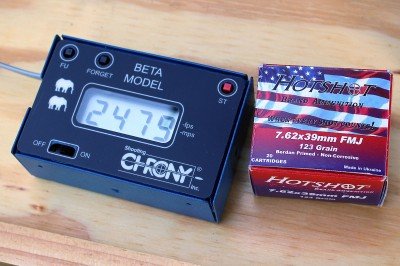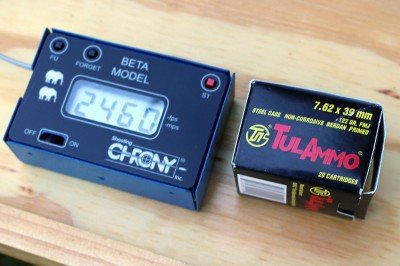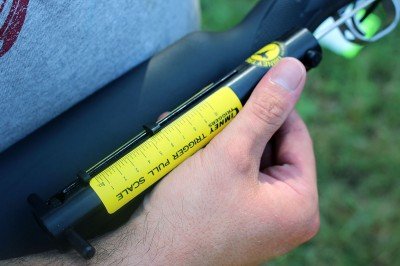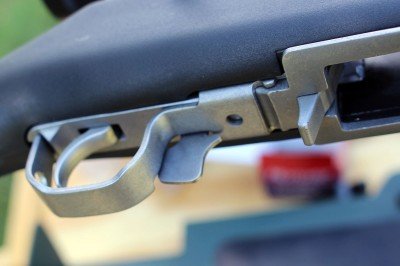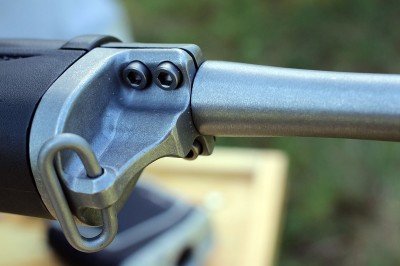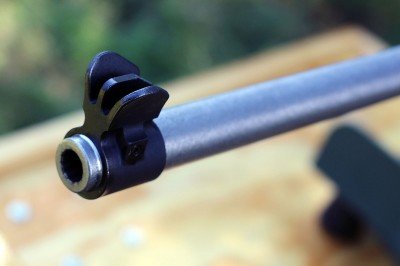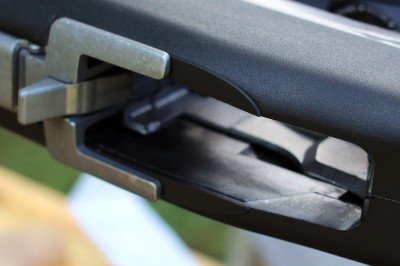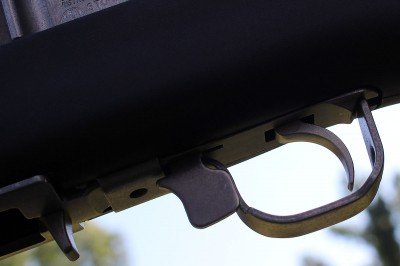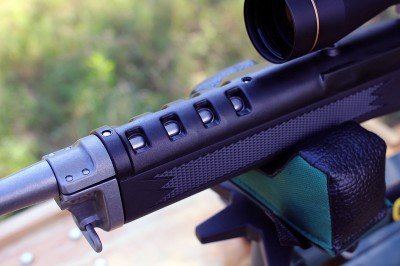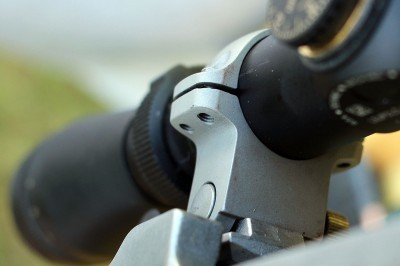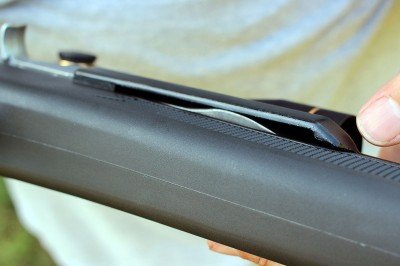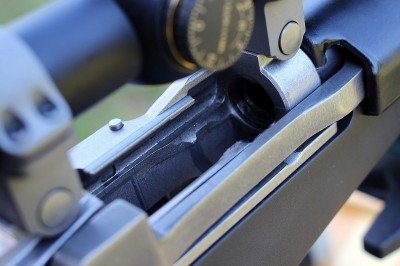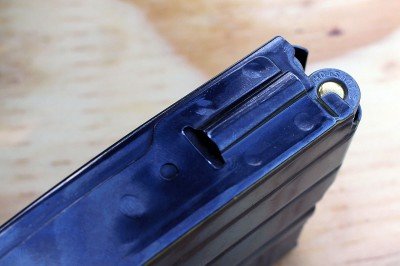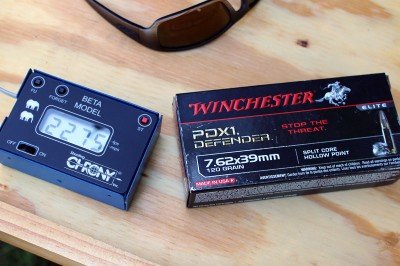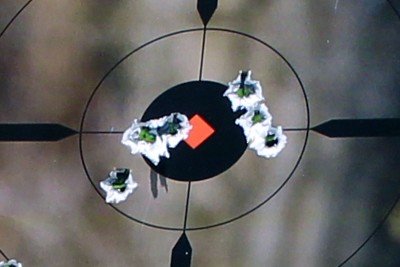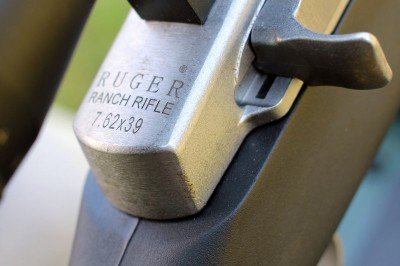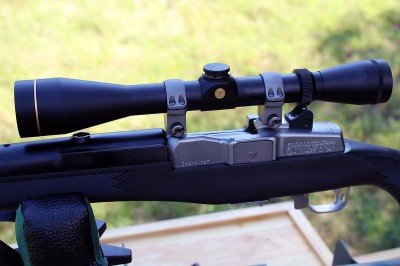[one_half]
Ruger Mini Thirty
By Sam Trisler
[/one_half]
[one_half_last] ![]()
[/one_half_last]
[full_width]
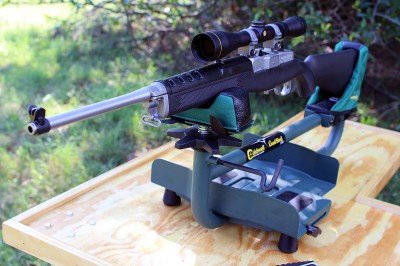 The Mini series rifles from Ruger are nothing new. They have been in production in various forms since 1973, and the action borrows from one that dates from the 1930s. They have shown up in Hollywood too: the original A Team used them. Still, they are a bit of a curiosity. After running this Mini Thirty through its paces, my opinion on them has risen: this is a very capable rifle with a couple of quirks.
The Mini series rifles from Ruger are nothing new. They have been in production in various forms since 1973, and the action borrows from one that dates from the 1930s. They have shown up in Hollywood too: the original A Team used them. Still, they are a bit of a curiosity. After running this Mini Thirty through its paces, my opinion on them has risen: this is a very capable rifle with a couple of quirks.
Design
The Mini-14 and Mini Thirty (yes, Mini-14 and Mini Thirty) are pretty much the same rifles in different calibers. The 14 is chambered in .223 or 5.56x45mm, while the Thirty fires 7.62×39. The Mini-14 was the first on the market and gets its name from the gun that inspired it, the M-14. If you are a student of U.S. military arms, you will know that the M-14 is pretty much an updated M1 Garand. The Ruger Minis have some nice roots in the family tree.
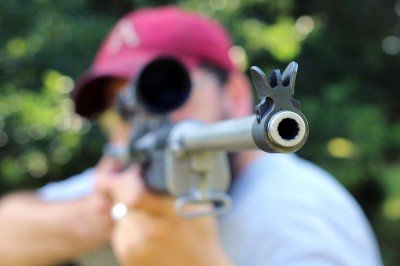
The larger .30 caliber round makes the Mini Thirty a great gun for hogs and whitetail and home defense.
Like the rifles that inspired them, the Ruger Minis have Garand-style actions that use fixed-piston gas systems. The receivers and bolts make them look like small Garands. The Minis have the operating rod on the side as well, although it is mostly covered by the hand guard. But that is the design of the Ruger Minis’ actions, scaled-down Garands. It doesn’t get much more American than that. And these are made in the USA. No 922-R to worry about. To some people that is a huge selling point. There are not too many AKs that carry that label, and they sure were not designed in the states.
The Mini Thirty
Ruger has updated the Mini line a handful of times over the years. The review gun Ruger sent us is the current standard model. If you are familiar with Ruger, you will know it makes slight changes to a lot of its products from year to year. This one sports an 18.5-inch barrel. It has a synthetic stock and is in the brushed stainless finish. The rifle weighs in at 6.75 pounds empty. The rear sight is a ghost ring and the front is a post, which is derived from its military lineage. It ships with two 20-round magazines, scope rings and a short piece of Picatinny rail that can be screwed on to the scope mounts. The current line has integral scope bases cast into the top of the receiver. The scope rings that came with the review gun fit one-inch scopes.
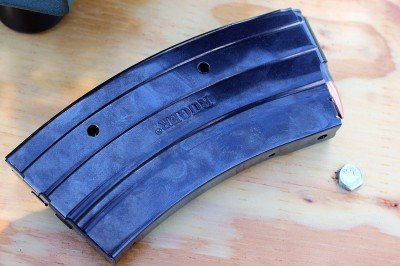
The steel magazines are solid as a tank, but they’re no AK mags. And AK mags won’t work. Who made that decision?
One of the complaints about the Minis has been their accuracy. We will get to how well this one preformed in a bit, but Ruger has done some things over the years to make this shoot tighter groups. These changes primarily involve the thickness of the barrel. That’s not to say these are going to be long-range target guns, nor does Ruger market them as such. These are 2-3 MOA guns.
Ruger ships the Mini Thirty with two 20-round magazines or with five-round ones if you are in an area that doesn’t allow the higher capacity. Here we have the first of what I call quirks. These are proprietary mags. Now these are high quality magazines, and I had zero issues with them. However they are not exactly cheap—they retail for about $40. I wish they would have made these compatible with AK or even AR mags. It’s no small gripe when you already have a metric ton of AK and AR mags around. Such a simple design element would be useful. Also in a SHTF scenario, having a weapon that uses a common magazine would be much more beneficial. But the Ruger mags are reliable and well made, and that is what ultimately counts.
Function
I took the Mini Thirty to the range a couple of times to run it through its paces. The first trip, I ran nothing but the cheapest steel-cased ammo I could find. These were Tula, Hot Shot and Monarch. These all fed and cycled as they should, but there were a number of misfires. The firing pin looked to be making a nice deep hits, but these are all known to have hard primers. There are aftermarket hammer springs that are stronger for this reason. Another quirk? Or the cost of shooting cheap ammo?
On the second trip, I also shot some Winchester PDX1 Defender that all fired without a problem. I experienced some more misfires with the Tula and the Hot Shot. The Hot Shot was by far the worst. The Tula seemed to have one or two misfires per box of 20. If I rechambered them, they would usually fire after the second strike. If I were going to use this Mini as a cheap round range plinker, I would definitely change out the hammer spring and see if that helps.
Range Numbers
The second trip to the range, I set up the chrony to take a few readings. I tested the Hot Shot 123gr, Tula 122 gr and the Winchester PDX1 Defender 120 gr. The Tula was the hottest, with an average of 2,443 ft/s, with the Winchester being the slowest at 2,317 ft/s. The Hotshot came in at 2,380 ft/s.
Accuracy
On the first trip to the range with the Mini Thirty, I used the stock ghost ring sights. I used my portable shooting bench and lead sled to see how close the sights were set out of the box. They were spot-on at 30 and 50 yards. Even with the cheap steel-cased ammo I was feeding, I was able to get nice tight groups of about one inch when the barrel was cold. That is the key here and another quirk. With a cold bore, this rifle is a tack driver. But when it warms up, it really starts to scatter the rounds. It took four or five rounds to get the barrel hot enough that accuracy started to fall off. This was the case with all of the different ammo.
On the second trip, I mounted up a Leupold 3-9×40 on the supplied Ruger rings. The rings mounted to the rifle with ease but the rings themselves had a few gaps that really should be lapped out. After sighting it in at 30 yards, I moved out to 100 and used the bench and sled. The first couple of shots from 100 yards were dead on, sub-MOA groups, but only for two shots. The third shot would usually be a couple of inches high, the fourth even higher and the ones after were three to four inches from the bulls eye in all directions. At first I thought the scope rings had shifted, but this was not the case. After letting the barrel cool down for 10 or 15 minutes it would tack drive the first two rounds then start to open up.
After shooting some patterns on a Birchwood Casey Pregame Whitetail Deer Target (which is surprisingly small at 100 yards), I moved over to a 12-inch steel plate. I shot these off hand. I loaded up 20 rounds of Tulammo and was able to consistently ring the steel from 100 yards. Eighteen out of 20 hits was the norm. The two misses were probably shooter error.
The Mini Thirty is a lot of fun to shoot. The 7.62×39 round is a good cheap plinker, and the recoil is very mild and not fatiguing. Ringing steel at 100 yards was where I really enjoyed shooting this. Even with the diminished accuracy of a hot barrel, the Mini Thirty would make the steel ring without fail. The trigger on this was actually pretty nice. There was a little bit of creep but no grit. The trigger broke cleanly at 5.1 pounds. Granted, that is heavy for a target rifle, but that’s not what the Mini Thirty is.
So what is it?
I have a little bit of a hard time finding where the Mini Thirty fits in to the range of firearms classifications. It’s not on the ban list in most places that have those. It is not a military arm, although it has been and continues to be used by law enforcement agencies. The Garand-style action does have a military history, though. It does use less-than-standard capacity magazines (if you consider 30 rounds the standard) but ships with five-round magazines to areas with a ban (which will still make a California Democrat wet the bed). It’s not a target rifle, although with a cold bore it is capable of sub-MOA shots. The 7.62 round, when loaded with soft points, makes a good 100-150 yard whitetail cartridge. The ballistics are very similar to the classic Winchester 30-30.
Thoughts
I liked the Mini Thirty a lot. I was a bit disappointed in how much the accuracy was affected by the hot barrel. That’s its final quirk. There are some aftermarket parts that are supposed to address this issue that I would really like to try out. It’s not accurate enough to be a competition target rifle. I would take it hunting though. It would be great as a brush gun or in other areas where your shots would not be much over 150 yards. The round is capable of taking deer and hog-size game and, with the cold bore shots common to most hunting situations, I would not be afraid of the rifle not doing its part. The magazine being proprietary is at most annoying for availability and price. but it does what it is supposed to. I can’t blame the rifle for the trouble with the hard primers on cheap ammo. If it had the same issues with the better-made Winchester stuff, I would have an issue with it. I do think that swapping to a higher-power hammer spring should fix this.
The Mini Thirty has an MSRP of $1039. The street price is lower, $750-775. Being able to plink with cheap ammo is one reason people buy rifles chambered for 7.62×39, but the Ruger Mini Thirty is so much more than that. These guns were good enough for the A Team, which is good enough for me.
[/full_width]
[one_half]
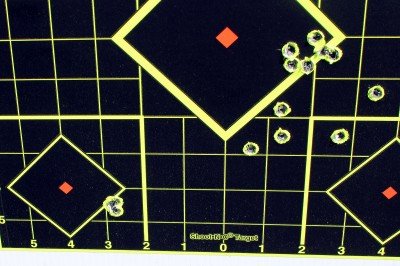
The group on the left, the small one, was shot with a cold barrel. The larger mess was shot with three different ammo types.
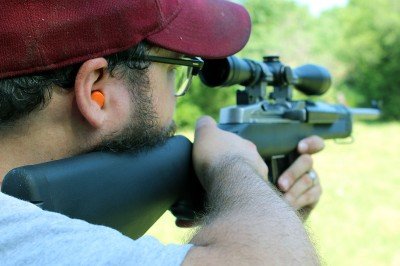
The Mini Thirty is kind of like a pickup truck. It goes well with a baseball hat and a pair of ratty jeans.
[/one_half]
[one_half_last]
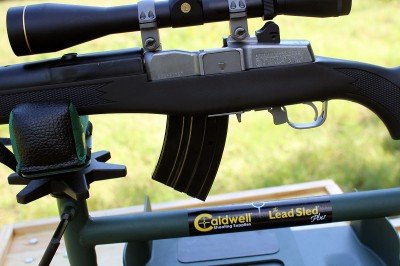
The one appeal of the 20 round mag comes when you put it in a sled, as it fits where a typical AK won’t.
[/one_half_last]
